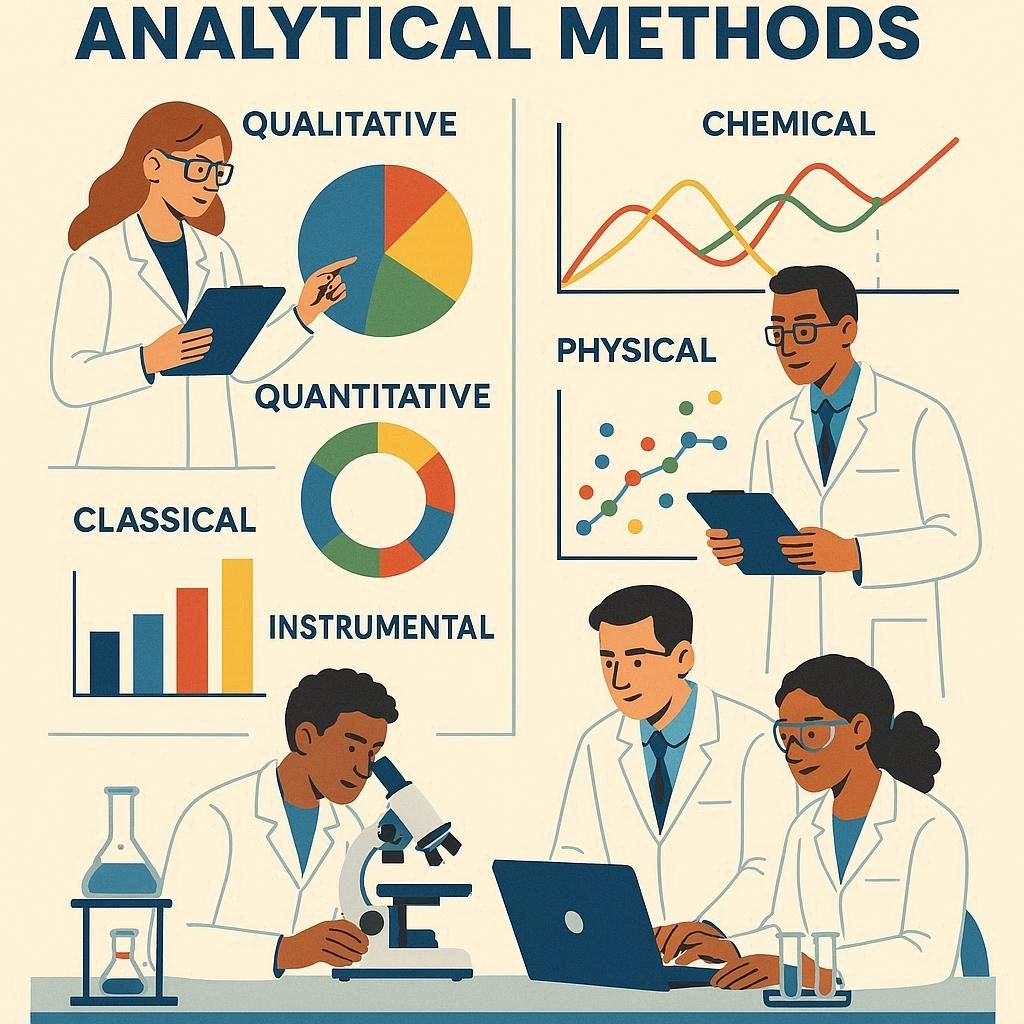
Classification of Analytical Methods is based on classical (wet chemistry, e.g., titration, gravimetry) and instrumental (e.g., spectroscopy, electrochemistry), and by their goals: qualitative (identifying substances) and quantitative (measuring amounts). Separation techniques, like chromatography, form a key category used to isolate components before analysis. Major Takeaway You May Like Classification Of Analytical Methods For Pharmaceutical Analysis […]
Classification of Analytical Methods is based on classical (wet chemistry, e.g., titration, gravimetry) and instrumental (e.g., spectroscopy, electrochemistry), and by their goals: qualitative (identifying substances) and quantitative (measuring amounts). Separation techniques, like chromatography, form a key category used to isolate components before analysis.
Major Takeaway
The four main types are:
1. Gravimetric methods – based on mass measurement
2. Titrimetric methods – based on volume measurement (e.g., titrations)
3. Spectroscopic methods – based on light absorption/emission (e.g., UV, IR)
4. Electroanalytical methods – based on electrical properties (e.g., pH, voltammetry)
1. Qualitative methods – identify the presence of substances
2. Quantitative methods – determine the amount or concentration
3. Structural methods – used for molecular structure elucidation (e.g., NMR, MS)
Analytical methods can be classified based on:
1. Nature of analysis: Qualitative and Quantitative
2. Technique used: Classical (wet chemistry) and Instrumental
3. Application: Pharmacopoeial, Bioanalytical, Stability, PAT
4. Detection principle: Spectroscopic, Chromatographic, Electrochemical, Thermal, etc.
Analytical methods are procedures used to identify, quantify, and characterize drugs and their components. They ensure the safety, efficacy, quality, and compliance of pharmaceutical products.
They are classified based on:
1. Purpose: Qualitative or Quantitative
2. Technique: Classical (wet chemistry) or Instrumental
3. Principle: Spectroscopic, Chromatographic, Electrochemical, etc.
4. Application: Pharmacopoeial, Stability, Bioanalytical, etc.
Based on factors such as:
1. Nature of the analyte (e.g., solubility, volatility)
2. Required sensitivity and specificity
3. Regulatory requirements (e.g., ICH, USP)
4. Available instrumentation and cost
1. Drug identification and assay
2. Impurity profiling
3. Stability testing
4. Quality control
5. Bioavailability and bioequivalence studies
Qualitative analysis determines what is present (identity)
Quantitative analysis determines how much is present (concentration or amount)
You May Like
The following are a structured classification of analytical methods used in pharmaceutical analysis:
| S.No. | Classification | Type / Principle | Examples |
|---|---|---|---|
| 1 | Identification tests, IR Spectroscopy, NMR, and Chemical spot tests | Qualitative Analysis | Acid-base, Redox, Complexometric, and Precipitation titrations |
| Quantitative Analysis | Assay, Content uniformity, Limit tests, UV-Vis, HPLC | ||
| 2 | Based on the Type of Analysis | Classical (Wet Chemical) | Based on the Nature of Analyte |
| Gravimetric Analysis | Weight of precipitate for analyte estimation | ||
| Spectroscopic Methods | UV-Vis, IR, NMR, MS, AAS, Fluorescence | ||
| Chromatographic Methods | HPLC, GC, TLC, UPLC, SEC, Ion Exchange | ||
| Electrochemical Methods | Potentiometry, Conductometry, Voltammetry, Polarography | ||
| Thermal Methods | DSC, TGA | ||
| X-ray Techniques | XRD (crystallinity), XRF | ||
| 3 | Based on Application | Pharmacopoeial Methods | Official methods (USP, BP, IP, EP) |
| Stability Testing | HPLC, UV for degradation studies | ||
| Bioanalytical Methods | LC-MS/MS, ELISA (for biological fluids) | ||
| Validation-Related Methods | ICH Q2 (R1) parameters: accuracy, precision, specificity, etc. | ||
| Process Analytical Technology (PAT) | NIR, Raman spectroscopy, real-time sensors | ||
| 4 | APIs, excipients – analysed by HPLC, UV, NMR | Organic Compounds | Metal ions, counterions – analysed by AAS, titrations |
| Inorganic Compounds | Proteins, peptides – analysed by LC-MS/MS, ELISA | ||
| Biological Molecules | Proteins, peptides – analyzed by LC-MS/MS, ELISA |
Further Learning
Quick Links